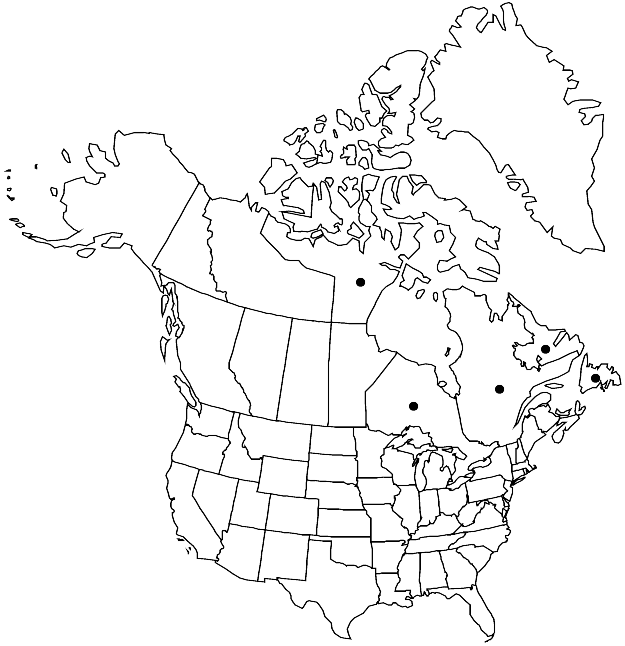Salix ballii
Canad. J. Bot. 53: 1501. 1975.
Plants 0.2–1.2 m. Stems: branches redbrown or yellowbrown, not glaucous (dull or slightly glossy), pubescent; branchlets redbrown or yellowbrown, (not or strongly glaucous), pubescent, villous, or short-silky, (inner membranaceous bud-scale layer free, not separating from outer layer). Leaves: stipules absent or rudimentary on early ones, foliaceous on late ones, apex acute or convex; petiole shallowly to deeply grooved adaxially, 2.5–7.5 mm, pubescent; largest medial blade elliptic to obovate, 23–63 × 10–35 mm, 1.4–2.8 times as long as wide, base convex or rounded, sometimes cordate or subcordate, margins flat, serrulate or sinuate, apex convex, rounded, acute, or acuminate, abaxial surface glaucous, glabrous, adaxial slightly glossy, glabrous or sparsely pubescent on midrib, (hairs white, sometimes also ferruginous); proximal blade margins serrulate or crenulate; juvenile blade sometimes reddish, glabrous, or midrib sparsely pubescent abaxially, hairs white, sometimes also ferruginous. Catkins flowering as leaves emerge; staminate stout, 17–29.5 × 8–11 mm, flowering branchlet 3.5–12 mm; pistillate moderately densely flowered, slender, stout, or subglobose, 10–37.5 (–45 in fruit) × 5–12 mm, flowering branchlet 2.5–16 mm; floral bract brown or bicolor, 0.8–1.6 mm, apex rounded, convex or retuse, abaxially hairy throughout or proximally, hairs straight, curly, or wavy. Staminate flowers: adaxial nectary oblong, square, or ovate, 0.3–1 mm; filaments distinct, glabrous; anthers yellow, 0.4–0.8 mm. Pistillate flowers: adaxial nectary square or oblong, 0.2–0.6 mm, shorter than stipe; stipe 0.8–2 mm; ovary pyriform, glabrous, beak gradually tapering to or slightly bulged below styles; ovules 12–18 per ovary; styles 0.4–1 mm; stigmas flat, abaxially non-papillate with pointed tip, or broadly cylindrical, 0.2–0.3–0.36 mm. Capsules 3–6 mm.
Phenology: Flowering late Jun-early Jul.
Habitat: Coastal barrens, terraces, ravines, talus slopes, coastal dunes, floodplains, Carex meadows, scrubby Picea mariana woods, dwarfed Abies balsamea thickets, Picea mariana-lichen-feathermoss woods, limestone and calcareous substrates
Elevation: 0-400 m
Distribution

Nfld. and Labr., Nunavut, Ont., Que.
Discussion
Occurrence of Salix ballii in Nunavut is on Charlton Island in James Bay.
Salix ballii differs from S. myrtillifolia in having leaves that are distinctly glaucous abaxially. It was described as S. myrtillifolia var. brachypoda by Fernald, who noted that among the characters that distinguish it from S. myrtillifolia only the presence of leaf glaucescence does not occur elsewhere in S. myrtillifolia. This character may be lost when dried over excessive heat. For example, the only specimen supporting the occurrence of S. myrtillifolia on the Gaspe Peninsula, Quebec, is a badly damaged, poorly dried collection that may have lost its glaucescence in drying. A single character difference such as this usually would not recommend a taxon for species rank, but in this case it may be justified inasmuch as S. ballii and S. myrtillifolia are allopatric. A specimen from Île Couture, Lac Mistassini Region, Quebec, may be an exception but confirmatory collections are needed.
Hybrids:
Salix ballii forms natural hybrids with S. glauca var. cordifolia (S. ×ungavensis Lepage). This sterile hybrid with aborted ovaries is known only from the type locality in northern Quebec. It generally resembles S. glauca var. cordifolia but its ovaries are glabrous except for hairy patches at the base and on the stipe. It is evidently a hybrid involving S. glauca var. cordifolia and a species with glabrous ovaries. E. Lepage (1962) was correct in suggesting that the latter was S. ballii (as S. myrtillifolia var. brachypoda). Both taxa grow together in the area; style and floral bract lengths fall within the range of S. ballii, except for a slight overlap with S. glauca var. cordifolia, and its serrulate to crenulate leaf margins are characteristic of S. ballii.
Selected References
None.
Lower Taxa
"-0.36mm" is not declared as a valid unit of measurement for this property.